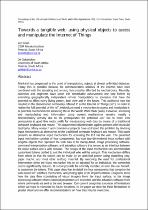 ResearchSpace
ResearchSpace
Towards a tangible web: using physical objects to access and manipulate the Internet of Things
JavaScript is disabled for your browser. Some features of this site may not work without it.
- ResearchSpace
- →
- Research Publications/Outputs
- →
- Conference Publications
- →
- View Item
| dc.contributor.author |
Smith, Andrew C

|
|
| dc.contributor.author |
Gelderblom, JH

|
|
| dc.date.accessioned | 2014-04-24T09:25:50Z | |
| dc.date.available | 2014-04-24T09:25:50Z | |
| dc.date.issued | 2013-09 | |
| dc.identifier.citation | Smith, A.C and Gelderblom, J.H. 2013. Towards a tangible web: using physical objects to access and manipulate the Internet of Things. In: Proceedings of the 15th Annual Conference on World Wide Web Applications 2013, 10-13 September, Cape Town, South Africa | en_US |
| dc.identifier.isbn | 978-0-620-59570-4 | |
| dc.identifier.uri | http://www.zaw3.co.za/index.php/ZA-WWW/2013/paper/view/823 | |
| dc.identifier.uri | http://hdl.handle.net/10204/7367 | |
| dc.description | Proceedings of the 15th Annual Conference on World Wide Web Applications 2013, 10-13 September, Cape Town, South Africa | en_US |
| dc.description.abstract | Mankind has progressed to the point of manipulating objects at almost unlimited distances. Today this is possible because the communication abilities of the internet have been combined with the actuating and sensing functionality afforded by mechatronics. Recently, scientists and engineers have taken this remarkable achievement one step further by extending geographically independent remote manipulation to scenarios that have the potential to affect every living person, both now and in the future. This additional step has resulted in the phenomenon commonly referred to as the Internet of Things (IoT). In order to realise the full potential of the IoT, individuals need a mechanism to access and manipulate it. A potential mechanism for achieving this is the World Wide Web (web). This paper presents an alternative input mechanism for accessing the IoT via the web. The presented input mechanism consists of four components: low-cost two-dimensional input surface with tangible objects that represent the web data to be manipulated, image processing software, command interpretation software, and actuation software that serves as an interface between the input surface and a web browser | en_US |
| dc.language.iso | en | en_US |
| dc.publisher | ZAWWW | en_US |
| dc.relation.ispartofseries | Workflow;11606 | |
| dc.subject | Internet of Things | en_US |
| dc.subject | IoT | en_US |
| dc.subject | Tangible User Interaction | en_US |
| dc.subject | Tangible web | en_US |
| dc.title | Towards a tangible web: using physical objects to access and manipulate the Internet of Things | en_US |
| dc.type | Conference Presentation | en_US |
| dc.identifier.apacitation | Smith, A. C., & Gelderblom, J. (2013). Towards a tangible web: using physical objects to access and manipulate the Internet of Things. ZAWWW. http://hdl.handle.net/10204/7367 | en_ZA |
| dc.identifier.chicagocitation | Smith, Andrew C, and JH Gelderblom. "Towards a tangible web: using physical objects to access and manipulate the Internet of Things." (2013): http://hdl.handle.net/10204/7367 | en_ZA |
| dc.identifier.vancouvercitation | Smith AC, Gelderblom J, Towards a tangible web: using physical objects to access and manipulate the Internet of Things; ZAWWW; 2013. http://hdl.handle.net/10204/7367 . | en_ZA |
| dc.identifier.ris | TY - Conference Presentation AU - Smith, Andrew C AU - Gelderblom, JH AB - Mankind has progressed to the point of manipulating objects at almost unlimited distances. Today this is possible because the communication abilities of the internet have been combined with the actuating and sensing functionality afforded by mechatronics. Recently, scientists and engineers have taken this remarkable achievement one step further by extending geographically independent remote manipulation to scenarios that have the potential to affect every living person, both now and in the future. This additional step has resulted in the phenomenon commonly referred to as the Internet of Things (IoT). In order to realise the full potential of the IoT, individuals need a mechanism to access and manipulate it. A potential mechanism for achieving this is the World Wide Web (web). This paper presents an alternative input mechanism for accessing the IoT via the web. The presented input mechanism consists of four components: low-cost two-dimensional input surface with tangible objects that represent the web data to be manipulated, image processing software, command interpretation software, and actuation software that serves as an interface between the input surface and a web browser DA - 2013-09 DB - ResearchSpace DP - CSIR KW - Internet of Things KW - IoT KW - Tangible User Interaction KW - Tangible web LK - https://researchspace.csir.co.za PY - 2013 SM - 978-0-620-59570-4 T1 - Towards a tangible web: using physical objects to access and manipulate the Internet of Things TI - Towards a tangible web: using physical objects to access and manipulate the Internet of Things UR - http://hdl.handle.net/10204/7367 ER - | en_ZA |





